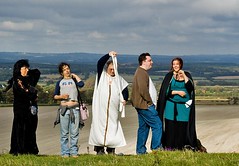Pagan Rituals And Wiccan Rituals
The modern usage of the word Paganism is an umbrella term that can include everything from Asatru (worship of Norse gods) to Hellenic (worship of Greek gods) traditions. The word pagan usually refers to a person who has a polytheistic religion; that is, a religion that includes more than one god or goddess. In older times, the word pagan was used to mean a godless person who was only interested in sensual pursuits, which, frankly, doesn’t sound like much of an insult to me! The word also had the connotation of unsophisticated, or country dweller, much like our modern words hick or redneck.
I think of modern pagans as being polytheistic, frequently nature based magical practioniers who are not bound by the Wiccan Rede and practice a religion that is not Christianity, Judaism, or Islam. Each group of gods and goddesses has different rules, after all.
Wicca, by contrast, is a new religion, originating only fifty or sixty years ago. It is partly based on what earlier generations may have practiced, but many Wiccan traditions step away from history entirely.
Wiccans generally celebrate Sabbats and Esbats, holidays based on seasonal changes. These celebrations as a whole are commonly referred to as the Wheel of the Year. Other terms that differentiate Wicca from Paganism are the Rede and the Rule of Three. The most important part of the Rede is the oft-quoted an it harm none, do what thou wilt, while the Rule of Three is a karmic law that states that all actions of the witch will reflect on him or her with three fold consequences, whether positive or negative.
While Wicca can be included under the umbrella of paganism, there are often differences in the rituals
Pages: 1 2
